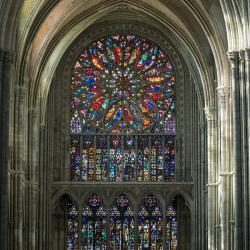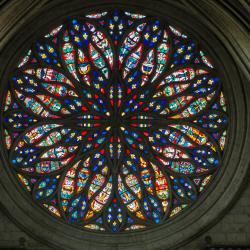Phase 5
The decades either side of 1500 saw an extraordinary flowering of stained glass production with the return to prosperity of cities like Amiens after the Hundred Years War and the struggle with the Burgundians. Families of glaziers thrived in cities like Troyes, Beauvais and, perhaps, Amiens. The austerity of grisaille was abandoned in favor of brilliantly-colored and delicately-painted glass where some effects of modeling and space might be introduced. At Amiens this final magnificent phase of stained glass production has left us two rose windows. The south transept rose was replaced around 1500, probably under the direction of Master Mason Pierre Tarisel. 24 brightly-colored angels have found their way into the sinuously-curved petals of the Flamboyant tracery. The designers have placed the angels' heads towards the center causing the lower angels to appear to surge upward while the upper angels plunge down. The west rose, donated by canon Robert de Cocquerel (d. 1521) who had been master of the confraternity of Notre-Dame du Puy, is equally brilliant and delicately painted with "Italianate" motifs. The non-figurative composition was intended to celebrate the reunion of the city of Amiens with the kingdom of France after the period of Burgundian domination. Golden fleurs-de-lys on a blue field are sprinkled at the extremities while the petals are filled with elaborate foliate composition, presumably to represent the ivy of the city of Amiens.
Just as the beginning of the Life of the Gothic Cathedral marked the triumph of France over the Plantagenets at Bouvines, the end celebrated the reunification of Kingdom and city.

